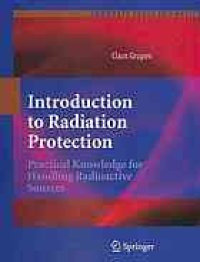
Ebook: Introduction to Radiation Protection: Practical Knowledge for Handling Radioactive Sources
Author: Claus Grupen (auth.)
- Tags: Biophysics and Biological Physics, Radiotherapy, Imaging / Radiology, Particle and Nuclear Physics, Measurement Science and Instrumentation, Nuclear Medicine
- Series: Graduate texts in physics
- Year: 2010
- Publisher: Springer-Verlag Berlin Heidelberg
- City: Berlin ; London
- Edition: 1
- Language: English
- pdf
The book presents an accessible account of the sources of ionising radiation and the methods of radiation protection. The basics of nuclear physics which are directly related to radiation protection are briefly discussed. The book describes the units of radiation protection, the measurement techniques, biological effects of radiation, environmental radiation, and many applications of radiation. For each chapter there is a problem section with full solutions. A detailed glossary and many useful information in appendixes complete the book. The author has addressed the issue of internationality to make sure that the text and, in particular, the complicated regulations can be easily interpreted not only in Europe and the United States but also in other countries. The subject of radiation protection requires a certain amount of mathematics. For those who have forgotten the basic rules of calculus a short refresher course in the form of a mathematical appendix is added.
Note continued: 8.15. Problems -- 9. Radiation Sources -- 9.1. Particle Radiation -- 9.2. Photon Sources -- 9.3. Neutron Sources -- 9.4. Cosmic-Ray Sources -- 9.5. Supplementary Information -- 9.6. Problems -- 10. X Rays and X-Ray Regulations -- 10.1. Supplementary Information -- 10.2. Problems -- 11. Environmental Radioactivity -- 11.1. Cosmic Rays -- 11.2. Terrestrial Radiation -- 11.3. Incorporation of Radioisotopes -- 11.4. Radiation Exposure by Technical Installations -- 11.5. Supplementary Information -- 11.6. Problems -- 12. Nuclear Power Plants -- 12.1. Nuclear-Fission Reactors -- 12.2. Fusion Reactors -- 12.2.1. Inertial Fusion -- 12.2.2. Fusion by Magnetic Containment -- 12.3. Supplementary Information -- 12.4. Problems -- 13. Biological Effects of Ionizing Radiation -- 13.1. Supplementary Information -- 13.2. Problems -- 14. Radiation Accidents -- 14.1. Supplementary Information -- 14.2. Problems -- 15. Non-Ionizing Radiation -- 15.1. Supplementary Information -- 15.2. Problems -- 16. Solutions to the Problems -- 16.1. Solutions to the Problems of Chapter 2 -- 16.2. Solutions to the Problems of Chapter 3 -- 16.3. Solutions to the Problems of Chapter 4 -- 16.4. Solutions to the Problems of Chapter 5 -- 16.5. Solutions to the Problems of Chapter 6 -- 16.6. Solutions to the Problems of Chapter 7 -- 16.7. Solutions to the Problems of Chapter 8 -- 16.8. Solutions to the Problems of Chapter 9 -- 16.9. Solutions to the Problems of Chapter 10 -- 16.10. Solutions to the Problems of Chapter 11 -- 16.11. Solutions to the Problems of Chapter 12 -- 16.12. Solutions to the Problems of Chapter 13 -- 16.13. Solutions to the Problems of Chapter 14 -- 16.14. Solutions to the Problems of Chapter 15 -- Formulary -- 17. Written Test on Radiation Protection -- 17.1. Problems. Note continued: 17.2. Solutions for the Written Test -- 18. Radiation-Protection Glossary -- Appendixes -- A. Table of Frequently Used Radioisotopes -- B. Exemption Limits for Absolute and Specific Activities -- C. Maximum Permitted Activity Concentrations Discharged from Radiation Areas -- D. Examples of Limits for Surface Contaminations -- E. Definition of Radiation Areas -- F. Radiation Weighting Factors wR -- G. Tissue Weighting Factors wT -- H. Physical Constants -- I. Useful Conversions -- J. List of Abbreviations -- K. List of Elements -- L. Decay Chains -- M. List of Isotopes Frequently Used in Nuclear Medicine and Radiology -- N. Critical Organs for Various Radioisotopes -- O. Simplified Table of Isotopes and Periodic Table of Elements -- P. Decay-Level Schemes -- Q. Introduction into the Basics of Mathematics -- Q.1. Derivatives and Integrals -- Q.2. Exponential Function -- Q.3. Natural Logarithm